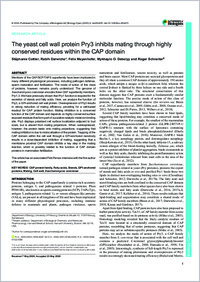The yeast cell wall protein Pry3 inhibits mating through highly conserved residues within the CAP domain
- Cottier, Stéphanie Department of Biology, University of Fribourg, Chemin du Musée 10, 1700 Fribourg, Switzerland
- Darwiche, Rabih Department of Biology, University of Fribourg, Chemin du Musée 10, 1700 Fribourg, Switzerland
- Meyenhofer, Felix Department of Biology, University of Fribourg, Chemin du Musée 10, 1700 Fribourg, Switzerland
- Debelyy, Mykhaylo O. Department of Biology, University of Fribourg, Chemin du Musée 10, 1700 Fribourg, Switzerland
- Schneiter, Roger Department of Biology, University of Fribourg, Chemin du Musée 10, 1700 Fribourg, Switzerland
-
15.06.2020
Published in:
- Biology Open. - 2020, vol. 9, no. 6, p. bio053470
English
Members of the CAP/SCP/TAPS superfamily have been implicated in many different physiological processes, including pathogen defense, sperm maturation and fertilization. The mode of action of this class of proteins, however, remains poorly understood. The genome of Saccharomyces cerevisiae encodes three CAP superfamily members, Pry1-3. We have previously shown that Pry1 function is required for the secretion of sterols and fatty acids. Here, we analyze the function of Pry3, a GPI-anchored cell wall protein. Overexpression of Pry3 results in strong reduction of mating efficiency, providing for a cell-based readout for CAP protein function. Mating inhibition is a conserved function of the CAP domain and depends on highly conserved surface exposed residues that form part of a putative catalytic metal- ion binding site. Pry3 displays polarized cell surface localization adjacent to bud scars, but is absent from mating projections. When overexpressed, however, the protein leaks onto mating projections, suggesting that mating inhibition is due to mislocalization of the protein. Trapping of the CAP domain within the cell wall through a GPI-anchored nanobody results in a dose-dependent inhibition of mating, suggesting that a membrane proximal CAP domain inhibits a key step in the mating reaction, which is possibly related to the function of CAP domain proteins in mammalian fertilization.
- Faculty
- Faculté des sciences et de médecine
- Department
- Département de Biologie
- Language
-
- English
- Classification
- Biological sciences
- License
- License undefined
- Identifiers
-
- RERO DOC 328813
- DOI 10.1242/bio.053470
- Persistent URL
- https://folia.unifr.ch/unifr/documents/308653
Other files
Statistics
Document views: 88
File downloads:
- cot_ycw.pdf: 216
- cot_ycw_sm.pdf: 93

